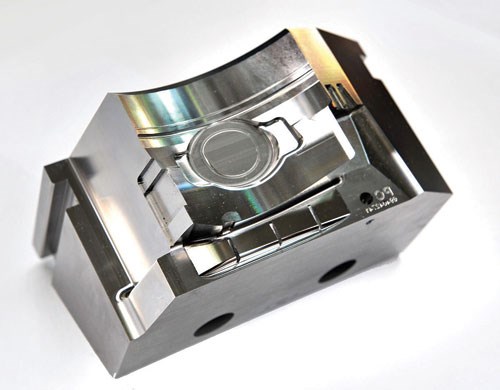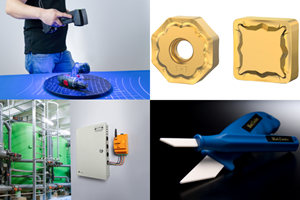Case Study: Software
CAM Package Streamlines Five-Axis Machining for Electronics/Medical Moldmaker
Share
Adept is a New Zealand-based plastics injection molding company that started more than 40 years ago and specializes in molding engineering plastics and difficult-to-mold components like carbon-fiber filled, high-temperature type materials. The toolroom was set up a few years after the factory and became known for supplying complete solutions—design, tooling and molding primarily for the medical market as well as the dental field and electronics industry. To take on these complex molds with intricate inserts as small as 1 to 2 square millimeters, Adept uses CAM-TOOL from CGS North America, Inc. (Oldcastle, ON).
“Recently, the toolroom has focused on tooling work that most companies won’t touch or don’t have the technology to attempt, like the above-mentioned very small intricate sizes and shapes,” explains Adept Tooling Manager Jason Yalden. “As components and carbide cutters become smaller (some as small as 0.2 mm), the need for high quality NC code becomes critical—as does selection of a good CAM package. Researching CAM packages is difficult because you need to really get in there and use them before you can see what they are really capable of. Fortunately, we have all had a great deal of experience with CAM so we know what to look for. Many companies have large fancy demos, but with CAM-TOOL we could see the value in the product. CGSNA thinks like us. It’s hard to explain, we just clicked.
“The biggest challenge is the necessity to make a product fit within such a small space,” Yalden continues. “The need to enclose so much functionally and power within a very small device is becoming the norm, which means we have to be able to machine intricate features to within microns. With many of our machined tooling parts used to mold products as small as the nail on your little finger now inspected under the microscope, toolmakers often find themselves working with an eyepiece, as you cannot inspect these features with the naked eye.”
These challenges—coupled with unpredictable code that may contain bugs that could possibly cause the cutter to cut unpredictably and also affect surface finish—led Adept to CAM-TOOL. “We selected CAM-TOOL because it was a small and specialized supplier specializing in moldmaking,” Yalden notes. “Our previous package came from a larger company, and we believe that although this package offered many features, it did not do one thing extremely well. It is clear that CGSNA has spent the time really refining their strategies.”
According to Yalden, CGS North America is well suited for Adept’s needs. “It’s incredibly responsive—our NC programmers have always been able to email or phone a CAM-TOOL consultant and get a response within 30 minutes,” he emphasizes. “That’s the kind of service we need since so much of what we do is right at the edge of being possible. We are always pushing for a solution to a complex problem—devising a strategy that will produce efficient code and surface finish.”
According to CGSNA President Randy Nash, the company’s moldmaking specialty originated in Japan. “In Japan there was in increasing push for miniaturization during the early 1990s,” Nash explains. “While other CAM software moved to shop floor programming CGS Japan (formerly Graphic Products) worked on the idea of unmanned machining and minimizing polishing on molds and dies. They needed to create a CAM engine that would output more accurate tool paths than the generic CAM software that existed. The focus on protecting the tool from overload, recognizing when tools or holders would rub on remaining stock, and outputting a tool path that the new CNC machines would embrace made it a perfect choice for moldmakers and die makers that were trying to accomplish those goals. These developments became more focused on high-speed and hard milling of molds and dies as these customers asked for more improvements.”
Adept uses CAM-TOOL for code creation. “We are in our ninth year of running CAM-TOOL and are very pleased with what they offer us,” Yalden says. “We use the software to generate both three- and five-axis code for tooling components which are fed to our Makino and Matsuura machining centers. With cavity features being so small (as 0.1mm) polishing after machining isn’t an option, so high quality code and good high-speed machining strategies is a must.”
Yalden notes that matching CAM-TOOL with its Matsuura MAM72 five-axis machine has resulted in massive gains in productivity. “Five sides can be machined from only one set-up—reducing set-up time required by the operator,” Yalden explains. “We’ve developed a production mindset to tooling components and aim to machine multiple parts of all types overnight with the goal of maximizing machine run times. Maximizing machine run time on multiple parts is a real challenge in toolmaking because everything is so different. In relation to cutters and labor, steel is cheap so machining multiple parts from a single block sees all the long code run during the night. Toolmakers can come to work in the morning and cut the parts from the upstanding block—and things like slides and small inserts are ready to go. Without the confidence of reliable machine code, we wouldn’t be able to do this.
“CAM-TOOL’s five-axis machining package has also drastically reduced the amount of labor required to build tooling,” Yalden adds. “Even with reduced labor, staff numbers remain the same. It just means we can get through a greater volume of work. Today, parts come off the machine and fit together first time without the need for hours of fitting and tuning.”
Adept is more than satisfied with CAM-TOOL. “Aim high right from the outset and start as you mean to finish,” Yalden concludes “With great software like CAM-TOOL you can expect quality from day one. CAM-TOOL gives us the confidence that the cavity will be right first time.”
Related Content
Tolerancing in Mold Design, Part 1: Understanding the Issues of Conventional Bilateral Tolerancing
Mold designers must understand the location, orientation and form limitations of conventional tolerancing before changing to another dimensioning system.
Read MoreNew Innovations in Mold Design, Milling Cutters, 3D Scanning
MoldMaking Technology compiles a number of digital-only products from the past month, including mold design software, laser metrology 3D scanners, milling cutters and more.
Read MoreMold Innovations Power Unique Auto Lighting Elements on Hummer EVs
Diamond machining, electroforming of micro-optical inserts and modified latch-lock system help injection molds produce unique forward lighting elements.
Read MoreProducts and Services for Multiple Moldmaking Needs
New year, new technology roundup! Featured here is a collection of product offerings, from profile milling cutters to industry-specific CAD/CAM software to innovative hot work tool steels.
Read MoreRead Next
How to Use Strategic Planning Tools, Data to Manage the Human Side of Business
Q&A with Marion Wells, MMT EAB member and founder of Human Asset Management.
Read MoreAre You a Moldmaker Considering 3D Printing? Consider the 3D Printing Workshop at NPE2024
Presentations will cover 3D printing for mold tooling, material innovation, product development, bridge production and full-scale, high-volume additive manufacturing.
Read MoreHow to Use Continuing Education to Remain Competitive in Moldmaking
Continued training helps moldmakers make tooling decisions and properly use the latest cutting tool to efficiently machine high-quality molds.
Read More





.jpg;maxWidth=300;quality=90)


















